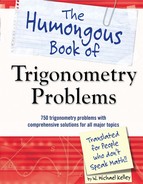In Chapter 2, you explore trigonometric ratios (via tables and calculator technology), but no rationale for the values of the functions is provided. Why do sine and cosine values range between–1 and 1, whereas the tangent and cotangent functions may grow infinitely large, in both the positive and negative directions? These are not questions you are yet equipped to answer, but this chapter provides a significant step in the right direction.
The unit circle is simply a circle, centered at the origin of the coordinate plane, with a radius equal to 1 unit in length. By graphing angles in standard position and examining the points at which their terminal sides intersect the unit circle, you generate the cosine and sine values of those angles (as well as the secant, cosecant, tangent, and cotangent values, which are based upon sine and cosine).
Now that you have worked through Chapter 2, you have some experience with sine and cosine functions. However, tables and calculators don’t tell the whole story. In this chapter, you work with unit circles, which are circles that have a center of (x,y) = (0,0) and a radius of r = 1. Believe it or not, these simple circles are the birthplace of sine and cosine—trig functions get their values from the coordinates of points on the circle. This chapter leads you step-by-step through the process, so take your time and soak it in.
By the end of the chapter, you will know the sine and cosine values of the 16 most commonly used angles in trigonometry. Forget tables—you’ll know these values off the top of your head with nary a calculation. Sure, there’s some memorization involved, but it’s worth it in the same way memorizing multiplication tables was worth it back in grade school.
